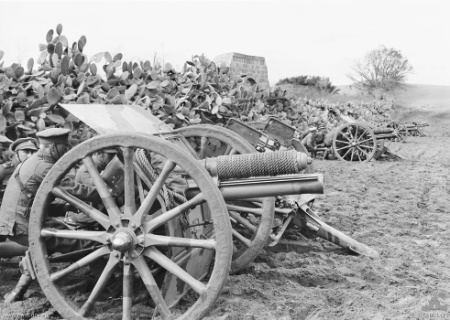Type Light field gun In service 1904–1940 (UK) No. built 416 | Place of origin United Kingdom Used by British Empire | |
 | ||
Wars World War I, Easter Rising, World War II | ||
The Ordnance QF 13-pounder (quick-firing) field gun was the standard equipment of the British and Canadian Royal Horse Artillery at the outbreak of World War I.
Contents
History
It was developed as a response to combat experience gained in the Boer War and entered service in 1904, replacing the Ehrhard QF 15 pounder and BL 12 pounder 6 cwt. It was intended as a rapid-firing and highly-mobile yet reasonably powerful field gun for Royal Horse Artillery (RHA) batteries supporting Cavalry brigades, which were expected to be engaged in mobile open warfare. It was developed in parallel with the QF 18-pounder used by field artillery.
The original Mk I barrel was wire wound. Later Mk II barrels had a tapered inner A tube which was pressed into the outer tube.
The first British artillery round on the Western Front in World War I was fired by No. 4 gun of E Battery Royal Horse Artillery on 22 August 1914, northeast of Harmignies in Belgium.
It saw action most famously at the Battle of Le Cateau in August 1914 as the British Expeditionary Force retreated from Mons.
It was used to great effect by "L" Bty, Royal Horse Artillery in its famous defensive action on September 1, 1914 at Néry, France, for which 3 Victoria Crosses were awarded. The medals, and No. 6 gun and limber involved in this action, are held in the collection of the Imperial War Museum.
From late 1914, when the Western Front settled into trench warfare, the 13-pounder was found to be too light to be truly effective against prepared defensive positions. As a result, a few RHA batteries that were not supporting cavalry formations converted to 18-pounder guns and 4.5 inch howitzers. However, it was retained in the British and Canadian cavalry brigades on the Western Front. and also used throughout the war in batteries (both RHA and Territorial Force) supporting cavalry and mounted formations in Palestine and Mesopotamia.
Batteries normally carried 176 rounds per gun, the gun and its filled limber (24 rounds) weighed 3668 lbs and was towed by a 6 horse team. All members of the gun detachments were mounted on their own horses.
As the war progressed, however, the increasing air activity created a requirement for a medium anti-aircraft gun. Some 13-pounders were slightly modified to become "Ordnance QF 13 pdr Mk III" and mounted on high-angle mounts to produce what became known as the 13 pounder 6 cwt anti-aircraft gun.
In 1940, some 13-pounders were brought out of store for use as emergency anti-tank guns, mounted in pill boxes, for the home defence of Britain against possible German invasion.
For combat purposes the gun is long obsolete, yet it remains in service with the King's Troop, Royal Horse Artillery for ceremonial purposes and as state saluting guns.
13 pounder 6 cwt QF Mark V naval gun
This was a pedestal mounted adaptation by Vickers Limited of the Mark I horse artillery gun, intended to arm the Royal Navy's new Motor Launches in World War I. 650 examples were constructed, including 250 made in the United States. Because of the German U-boat campaign, many of the guns were used to equip Defensively Armed Merchant Ships, some being removed from motor launches for that purpose.
